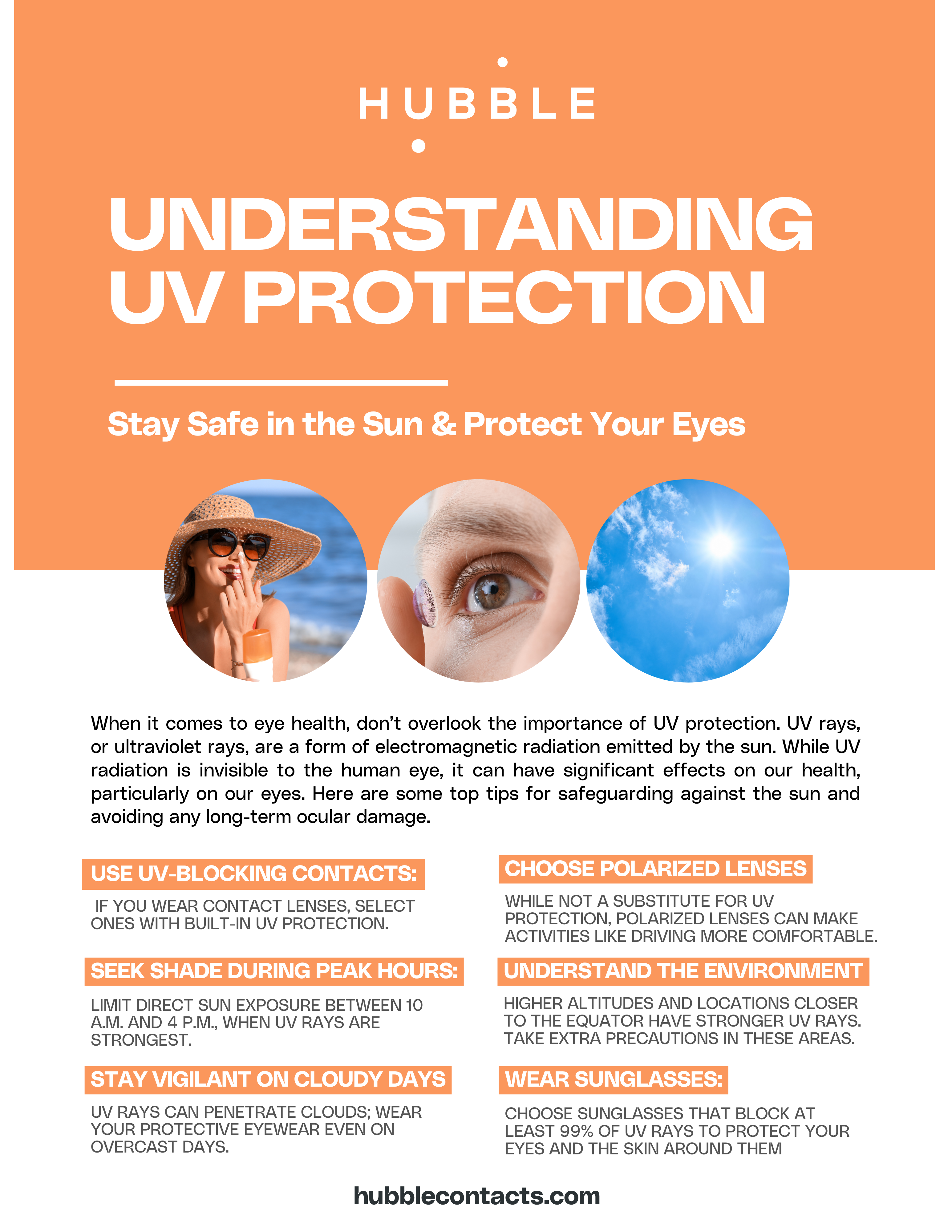Understanding UV Protection: Why Your Eyes Need It

When it comes to eye health, one crucial aspect that often goes overlooked is the importance of UV protection. In this blog post, we're shining a light on this vital, yet often underestimated aspect of eye care. Our exploration today focuses on the significance of shielding our eyes from the potentially harmful effects of UV rays. This is particularly important for those who rely on visual aids like contact lenses or glasses. We’ll delve into the various types of UV filters available, examining their role in eye health and how they help avert long-term ocular damage.
Here at Hubble, we are dedicated to offering solutions that not only enhance vision but also provide essential protection. We will discuss how integrating UV protection into eyewear can offer substantial benefits, especially for those who use contact lenses or glasses. Our commitment extends to providing a range of eyewear options, including contact lenses, glasses, and sunglasses that are equipped with UV protection, ensuring both comfort and the health of your eyes. Join us as we unravel the reasons behind the need for UV protection and how it contributes to sustaining healthy vision.
The Science Behind UV Rays and Eye Health
UV rays, or ultraviolet rays, are a form of electromagnetic radiation emitted by the sun. While UV radiation is invisible to the human eye, it can have significant effects on our health, particularly on our eyes. Understanding the different types of UV rays and their potential impact on eye health is crucial for protecting our vision.
There are three main types of UV rays: UVA, UVB, and UVC.
UVA Rays - These are the most abundant type of UV rays reaching the Earth's surface. While they are less intense than UVB rays, they can penetrate the skin and eyes more deeply. UVA rays contribute to premature aging of the skin and can play a role in the development of cataracts and macular degeneration, two common eye conditions.
UVB Rays - UVB rays are more energetic than UVA rays and are partially absorbed by the Earth's ozone layer. However, a significant amount still reaches the surface. UVB rays are the primary cause of sunburn and are strongly linked to the development of skin cancer, including cancers of the eyelids and the skin around the eyes. Additionally, UVB exposure can lead to photokeratitis, a painful condition similar to sunburn but affecting the cornea.
UVC Rays - UVC rays are the most energetic and potentially harmful type of UV radiation. Fortunately, the Earth's atmosphere absorbs all UVC rays, so they do not reach the surface and pose no direct threat to our eyes or skin.
Excessive exposure to UV rays can lead to various eye health problems, including:
Cataracts - A clouding of the eye's natural lens, leading to blurred vision and, if left untreated, can cause blindness.
Macular Degeneration - Damage to the macula, the part of the retina responsible for central vision, leading to vision loss.
Photokeratitis - A painful condition resembling sunburn of the cornea, causing temporary vision loss, sensitivity to light, and discomfort.
Pterygium - An abnormal growth of tissue on the surface of the eye, which can cause irritation, redness, and in severe cases, vision impairment.
Types of UV Rays: Understanding UVA and UVB
UVA and UVB rays are two types of ultraviolet light that can have distinct effects on eye health. UVA rays, although emitting the least energy, can cause skin aging, sunspots, and skin cancer. These rays can easily pass through the cornea and reach the lens, potentially leading to conditions like cataracts and macular degeneration. On the other hand, UVB rays emit slightly more energy than UVA and are responsible for sunburns and most UV-related cancers. Overexposure to UVB radiation can lead to photokeratitis, a condition akin to snow blindness that causes temporary vision loss.
To protect your eyes from the harmful effects of UVA and UVB rays, wearing sunglasses that block 100% of both types of radiation is crucial. Sunglasses should also screen out a significant percentage of visible light and fit well to prevent light from entering around the frames. It's essential to be mindful of UV exposure even on cloudy days as UV rays can penetrate through clouds and still pose a risk to eye health. By taking these preventive measures, individuals can significantly reduce their risk of developing eye problems associated with UV exposure.
Long-Term Effects of UV Exposure on Eyes
Exposure to ultraviolet (UV) radiation can have various consequences on eye health, ranging from short-term discomfort to long-term vision problems.
Prolonged exposure to UV radiation, particularly UVA rays, is a significant risk factor for the development of cataracts. Cataracts are characterized by clouding of the eye's natural lens, leading to blurry or dim vision, glare sensitivity, and difficulty seeing at night. UV radiation contributes to the breakdown of proteins in the lens, accelerating the formation of cataracts over time.
UV exposure is also associated with an increased risk of age-related macular degeneration (AMD), a leading cause of vision loss in older adults. AMD affects the macula, the central part of the retina responsible for sharp, central vision. Chronic UV exposure can damage the macula's cells, leading to the development and progression of AMD, which may result in irreversible vision loss.
UV Protection Glasses and UV Protection Contact Lenses: Protect Your Eyes

UV filters in glasses and contact lenses play a crucial role in protecting the eyes from the harmful effects of ultraviolet (UV) radiation. Here's how these filters work to safeguard your eyes:
UV Coating - Many sunglasses come with a UV filter lens coating that blocks harmful UV rays. This coating acts as a defensive barrier, reducing the amount of UV light that reaches your eyes.
Materials with Built-in Protection - Some eyewear materials like polycarbonate or high-index plastics inherently block UV radiation, providing built-in protection without additional coatings
UV Filters - Contact lenses with a UV filter absorb ultraviolet radiation, limiting the amount that reaches the surface of your eye. They provide an extra layer of protection against harmful UV rays that can enter through the sides
UV Protection in Glasses: More Than Just Tint
UV protection in glasses, including prescription sunglasses, is typically achieved through the use of special lens coatings or materials that block harmful ultraviolet (UV) radiation from reaching the eyes. Here's how it's usually incorporated:
UV-Blocking Lens Materials - Certain lens materials inherently block UV radiation without needing additional coatings. Polycarbonate and Trivex lenses, for example, naturally provide 100% UV protection, making them popular choices for sunglasses, especially for those with active lifestyles.
UV-Blocking Lens Coatings - Many lenses, including those made from materials like glass or regular plastic, can be coated with UV-blocking materials. These coatings are transparent and do not affect the appearance of the lens but effectively block UV rays from passing through. All Frames by Hubble Sunglasses come with polarized lenses that block 99% of UVA/UVB rays and eliminate daytime glare.
Polarization - While not directly related to UV protection, polarized lenses are commonly used in sunglasses. They reduce glare from reflective surfaces like water, snow, and roads, providing better visual clarity and comfort. Many polarized lenses also offer UV protection, adding an extra layer of defense for your eyes.
It's essential to prioritize UV protection when selecting sunglasses or prescription glasses online, as prolonged exposure to UV radiation can lead to various eye problems, including cataracts, macular degeneration, and photokeratitis.
Advancements in UV Protection for Contact Lenses
The field of UV protection for contact lenses has seen several innovations aimed at providing better protection and comfort for wearers. Here are some of the latest advancements:
Embedded UV Filters - Contact lenses with embedded UV filters directly in the lens material offer consistent UV protection throughout the lens. These filters block a significant portion of both UVA and UVB radiation, helping to shield the cornea and surrounding eye tissues from harmful UV rays.
Daily Disposable Lenses - Hubble’s Daily disposable contact lenses offer a convenient way to ensure consistent UV protection. Since these lenses are discarded after each use, there's no buildup of deposits or degradation of UV-blocking properties over time, ensuring that wearers receive optimal UV protection every day. Our original Classic by Hubble contacts offer UV protection, in addition to 55% water content for all-day comfort.
Integration with Lens Materials - Advances in lens materials have enabled the integration of UV-blocking properties directly into the lens matrix. This integration ensures that UV protection is inherent to the lens material itself, rather than relying on surface coatings that may degrade over time.
Smart Contact Lenses - Although still in the development stage, researchers are exploring the potential of smart contact lenses that can dynamically adjust their UV protection based on environmental conditions.
UV Protection in Multifocal Lenses - Multifocal contact lenses, designed to correct presbyopia, now often include UV protection features. This ensures that wearers with multifocal needs can benefit from both vision correction and UV shielding.
FDA Approval and Standards - The FDA and other regulatory bodies continue to refine standards for UV protection in contact lenses, ensuring that products on the market meet rigorous safety and efficacy requirements. In addition to offering built-in UV protection with our Classic by Hubble Contacts, all of our lenses have been FDA-approved for sale in the US for over a decade.
Choosing the Right UV Protection for Your Eyes
When selecting appropriate UV protection for different lifestyles and needs, it is essential to consider various factors to ensure comprehensive eye and skin safety.
UV Protection for Everyday Wear: Glasses and Sunglasses
Finding the perfect pair of glasses and sunglasses is based on a few things - prescription needs, frame color, frame shape, frame fashion trends, and material of the frame. Of course, the UV protection level is to be taken into consideration as well when shopping online for sunglasses and eyeglasses. All Frames by Hubble eyeglasses block 99% of UVA/UVB rays. Here are some tips to help you select the right UV-protective eyewear:
Look for UV Protection - Ensure that the eyewear you choose offers protection or blocks 100% of both UVA and UVB rays. This level of protection is crucial for shielding your eyes from harmful UV radiation.
Check Labels and Certifications - Look for labels or certifications indicating that the eyewear meets recognized UV protection standards. These may include certifications from organizations like the American National Standards Institute (ANSI) or the European Union's CE marking.
Consider Prescription Needs - If you require prescription eyewear, opt for UV-protective lenses in your prescription sunglasses or regular glasses. Many eyewear brands offer prescription options with UV protection, allowing you to maintain clear vision while safeguarding your eyes from UV radiation.
Consider Lens Material - Opt for lenses made from materials that inherently provide UV protection, such as polycarbonate or Trivex. These materials offer built-in UV-blocking properties and are commonly used in sunglasses and sports eyewear.
Fit and Comfort- Ensure that the eyewear fits comfortably and securely on your face without slipping or causing pressure points. Proper fit is essential for both comfort and effective UV protection.
UV Protection for Contact Lens Wearers
For contact lens wearers, selecting lenses with UV protection is an essential aspect of maintaining eye health, especially for those who spend a lot of time outdoors. Here's some advice for choosing contact lenses with UV protection:
Consult with an Eye Care Professional - Before selecting contact lenses with UV protection, schedule an appointment with an eye care professional, such as an optometrist or ophthalmologist. They can assess your eye health, evaluate your lifestyle and visual needs, and recommend the most suitable contact lenses with UV protection.
Opt for Lenses with Embedded UV Filters - Choose contact lenses that feature embedded UV filters directly within the lens material. These lenses offer consistent UV protection without the need for additional coatings that may degrade over time.
Consider Extended UV Protection - Look for contact lenses that provide extended UV protection, covering not only the cornea but also the limbal area surrounding the iris. Extended UV protection can help safeguard vulnerable parts of the eye from harmful UV radiation.
Select Daily Disposable Lenses - If you're concerned about UV protection, consider daily disposable contact lenses with built-in UV blockers. These lenses offer the advantage of fresh, clean lenses every day, ensuring consistent UV protection without the need for maintenance or lens care solutions.
Verify UV Protection Level - Check the packaging or product information to verify the level of UV protection provided by the contact lenses. Look for lenses that offer high levels of UV blocking, ideally blocking both UVA and UVB radiation.
Combine with Sunglasses - While UV-protective contact lenses offer valuable protection, they should not be a substitute for sunglasses with UV-blocking capabilities. Consider wearing sunglasses alongside UV-protective contact lenses for comprehensive eye protection, especially when spending extended time outdoors.
Follow Care Instructions - Adhere to proper contact lens care and maintenance practices as recommended by your eye care professional and the lens manufacturer. Proper cleaning and storage helps ensure that the lenses maintain their UV protection properties over time.
Regular Eye Exams - Schedule regular eye exams to monitor your eye health and the performance of your contact lenses with UV protection. Your eye care professional can assess any changes in your vision or eye health and make adjustments to your contact lens prescription or UV protection needs accordingly.
Hubble's Commitment to Eye Protection: UV Options
Explore Hubble Contacts range of comfortable and affordable contact lenses and experience the ultimate in UV protection. Your eyes are unique, and your contact lenses should be too. And with FDA-approved lenses and a user-friendly approach, Hubble Contacts is here to provide you with clear and comfortable vision for less.
Frames by Hubble feature polycarbonate lenses that are light, built to last, and impact-resistant, giving you the maximum use of each pair of eyeglasses or sunglasses. Hubble's frames come with polarized lenses that shut out 100% of UVA and UVB rays and reduce pesky glare.
Explore Hubble's UV Protective Glasses and Sunglasses
At Hubble, we aim to be the one-stop destination for all of your vision needs, including Frames by Hubble which feature polarized lenses that block 99% of UVA/UVB rays. Hubble is committed to catering to the evolving vision needs of our customers with eyeglasses and sunglasses that are suitable for every unique need and style.
Hubble's UV Protection Contact Lenses: Safety and Comfort
Our Classic by Hubble lenses remain priced at $1 for your first order of a 15 day-supply and feature UV protection, which is made up of 55% water composition. They boast a sleek edge for effortless insertion and enduring all-day comfort.
Safeguarding Your Vision with UV Protection and Hubble
Understanding the importance of UV protection for your eyes, you can take steps to ensure your eyes reflect the very best in comfort and clarity. UV protection provides significant safeguarding of our eyes from harmful UV rays, especially for individuals who wear contact lenses or glasses.
Shop our Eyeglasses, and Sunglasses with built-in UV Protection, or start your daily contacts subscription today!


